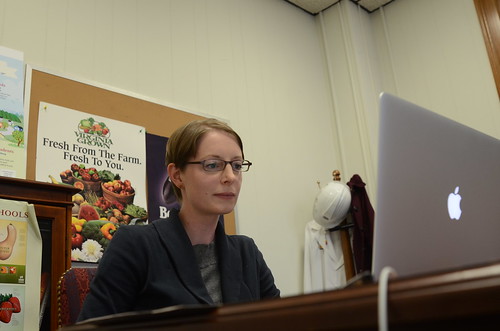What do Tristan Reader of Tohono O’odham Community Action (TOCA), Amy Bacigalupo of the Land Stewardship Project in Minnesota, Haile Johnston of Common Market in Philadelphia and Michael Todd’s environmental studies class at Ames High School in Ames, IA have in common? They’re all building connections between farms and consumers and creating strong local food systems in their communities. And all joined me for a Google+ Hangout – a live, virtual panel – on Thursday, November 21 to discuss their work.
There is amazing energy surrounding the development of local food systems in communities nationwide, and our discussion certainly reflected that. But it also came at a time of uncertainty. Congress has yet to pass a Food, Farm and Jobs bill, the major piece of legislation funding USDA’s local food efforts (along with many other critical programs). Until a bill is passed, many of the key resources for producers, businesses and communities engaged in local food systems are without funding. That reality lent a sense of urgency to some of the topics we discussed.
Nonetheless, the successes these groups and individuals have already had was inspiring. I learned about how the Land Stewardship Project has used USDA’s Beginning Farmer and Rancher Development Program to train new and beginning farmers in Minnesota and how TOCA is using the Farmers Market Promotion Program and the Small Socially-Disadvantaged Producer Grants Program to support local food security in the Tohono O’odham Nation in southern Arizona. Haile Johnston of Common Market, a food hub, spoke about how their organization’s recent Community Food Project award will continue their work to use local food to increase healthy food access in Philadelphia’s low-income communities.
Students from Ames High School in Iowa joined the conversation to describe how their participation on the Lexicon of Sustainability’s Project Localize art project gave them a first-hand look at sustainable agriculture. “Doing this project made me want to be a farmer,” said Elena Ingram, a senior at Ames High School. A Food, Farms and Job bill will provide renewed funding for many of the programs that help young farmers get their start.

Each panelist spoke eloquently and passionately about how USDA programs have supported their work. They were loud and clear that without a Farm Bill and USDA resources, this important work they do in the local and regional food community is at stake.
But don’t take my word for it. Take theirs. You can view the entire conversation at http://www.youtube.com/watch?v=pnBI5VYRhOU.
You can also see how the Farm Bill is at work supporting local and regional food in your community on the Know Your Farmer, Know Your Food Compass. Learn more about USDA’s work on local and regional foods to date with our new fact sheet. And continue the conversation about how the Farm Bill affects you by using the hashtag #MyFarmBill on any social media platform.
